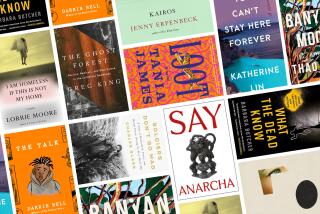Dissecting the doctor
- Share via
I often see undetected fear in patients’ eyes as they traverse our complex medical system trying to figure out how to get their worries, aches and pains heard and cured. I work with doctors every day as they interact with various patients and families. But only after reading “How Doctors Think” by Jerome Groopman MD did I realize that I saw only their actions and reactions. Never was I privy to the reflecting, reviewing and even, at times, soul-searching that doctors do over their patients and diagnoses -- the roads they mentally travel and the effect it can have on their patients.
Groopman, the author of “The Anatomy of Hope” and other books and a staff writer at the New Yorker, draws us into his world, presenting us with a detailed, articulate picture of modern medicine as the thinking mind intersects with new medical technologies.
“How Doctors Think” is timely because today, more than ever before, patients are required to take responsibility for their own healthcare. The days when one doctor would take care of everything for you are long gone. We no longer can present ourselves to the family doctor of many years and sit back and relax, knowing that we will be fully cared for without any attention required on our part.
Groopman gives us glimpses into the minds of mostly brilliant physicians, as well as a few who have missed the mark. Through the interviews he conducted with physicians from a variety of specialties, he lets us know that patients are more vulnerable than ever in the current fast-paced medical system. His book, and the thinking that inspires it, provide valuable insights that may be just the right medicine.
Anne Dodge, a young woman mistakenly diagnosed with bulimia and anorexia nervosa, “had lost count of all the doctors she had seen over the last fifteen years, she guessed it was close to thirty,” Groopman writes. “One doctor began to question, and listen, and observe, and then to think differently about Anne’s case. And by doing so, he saved her life. Because for fifteen years a key aspect of her illness had been missed.”
His central idea shows up clearly and early in the book. “Every doctor makes mistakes in diagnosis and treatment,” he writes. “But the frequency of those mistakes, and their severity, can be reduced by understanding how a doctor thinks and how he or she can think better.”
Groopman dissects doctors’ thinking and neatly packages it into simple and accessible terms that suggest why it sometimes leads to faulty actions. He introduces us to terms such as “diagnosis momentum” -- when a diagnosis becomes fixed in the mind of the physician despite incomplete evidence. Or “availability,” which means the tendency to judge the likelihood of a medical event by the ease with which relevant examples come to mind. He takes phrases patients often hear, such as “we see this sometimes” and puts forth the idea that such generic comments deserve further questioning from the patients. Though he uses medical terms, Groopman makes them understandable.
Groopman’s writing style grabs the reader’s attention by making his characters come alive on the page -- so much so, in fact, that the reader truly cares about the medical dilemmas they are facing. He gives us more information about the patients than most books of this genre, so that we can follow the doctors’ thinking and understand how their decisions are made. It is difficult to forget people like Anne Dodge because Groopman writes about their lives and frustrations. I was fascinated, disturbed and captivated by the real-life dramas his doctors face in their triumphs and mistakes.
Along with what doctors think about medical management of illnesses, the author surprises us with stories of how doctors think and feel about patients and how it changes the care they receive. It is no surprise that a doctor who secretly dislikes a patient may rush him through or make him feel like he is on an assembly line, but Groopman also explores the unexpected effect of being liked by the doctor.
The reader finishes this book feeling connected, especially because of Groopman’s willingness to include his own frustrations as a patient. Groopman inspires trust from us when, as a patient, he receives four different opinions on what is causing debilitating pain and swelling in his right hand. He tells some of the doctors who care for him that he is also a physician, but sometimes he doesn’t see where this will lead.
Groopman gives a brief mention of how modern evidence-based medicine competes with the art of using your intuition. He touches on how drug and insurance companies pressure doctors as he vividly explores their influence via big drug company sales representatives. I would have liked him to have written more about the influence of insurance companies, an area barely touched on, and about finances. This might have given readers a more complete picture of the intersection of medicine and finances.
There is a paradoxical experience to be had in reading Groopman’s interviews with doctors about their sometimes-flawed thinking. Though you would expect to walk away paranoid or at least leery of medical errors, I was left with a broader respect for the art of medicine and the careful consideration Groopman’s doctors give to their patients. “How Doctors Think” is a solid, well-considered prescription for doctors and their patients to read.
David Kessler is the author of “The Needs of the Dying” and coauthor with Elisabeth Kubler-Ross of “Life Lessons” and “On Grief and Grieving.”






